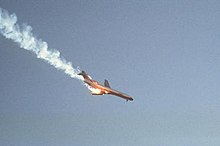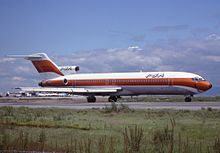PSA Flight 182

A photo taken of N533PS seconds after collision with Cessna 172
|
|
| Accident summary | |
|---|---|
| Date | September 25, 1978 |
| Summary | Mid-air collision resulting from pilot error and ATC error |
| Site | San Diego, California, United States |
| Total fatalities | 144 (including 7 on ground) |
| Total injuries (non-fatal) | 9 (on ground) |
| Total survivors | 0 |
| First aircraft | |
 A PSA Boeing 727 similar to the one involved in the accident |
|
| Type | Boeing 727-214 |
| Operator | PSA |
| Registration | N533PS |
| Flight origin | Sacramento Int'l Airport |
| Stopover | Los Angeles Int'l Airport |
| Destination | San Diego Int'l Airport |
| Passengers | 128 |
| Crew | 7 |
| Fatalities | 135 (all) |
| Survivors | 0 |
| Second aircraft | |
 a Cessna 172 similar to the one involved in the accident |
|
| Type | Cessna 172 |
| Operator | Gibbs Flite Center, Inc. |
| Registration | N7711G |
| Flight origin |
Montgomery Field San Diego, California |
| Crew | 2 |
| Fatalities | 2 (all) |
| Survivors | 0 |
Pacific Southwest Airlines (PSA) Flight 182 was a Boeing 727-214 commercial airliner, registration, N533PS that collided with a private Cessna 172 light aircraft, registration, N7711G over San Diego, California, at 9:01 am on Monday, September 25, 1978. It was Pacific Southwest Airlines' first accident involving fatalities. The death toll of 144 makes it the deadliest aircraft disaster in California history. Until the crash of American Airlines Flight 191, it was also the deadliest plane crash in U.S. aviation history.
Both aircraft crashed into North Park, a San Diego neighborhood. Flight 182 impacted just north of the intersection of Dwight and Nile, killing all 135 people aboard the aircraft and seven people on the ground in houses, including two children. The Cessna impacted on Polk Ave. between 32nd St. and Iowa St. killing the two on board. Nine others on the ground were injured and 22 homes were destroyed or damaged by the impact and debris.
The PSA 182 accident caused the revision of air traffic rules applicable to the busiest airports across the U.S., with the intention of improving separation of aircraft operating in the vicinity of large airports.
On the morning of Monday, September 25, 1978, Pacific Southwest Airlines Flight 182 departed Sacramento for San Diego via Los Angeles. The seven-person, San Diego-based crew was Captain James McFeron, 42, First Officer Robert Fox, 38, Flight Engineer Martin Wahne, 44, Flight Attendant Karen Borzewski, 29, Flight Attendant Katherine Fons, 20, Flight Attendant Deborah McCarthy, 29, and Flight Attendant Dee Young, 26.
The flight from Sacramento to Los Angeles was uneventful. At 8:34 am, Flight 182 departed Los Angeles. First Officer Fox was the pilot flying. The 128 passengers on board included 29 PSA employees. The weather in San Diego that morning was sunny and clear with 10 miles (16 km) of visibility. At 8:59, the PSA crew was alerted by the approach controller about a small Cessna 172 Skyhawk aircraft nearby. The Cessna was being flown by two licensed pilots. One was Martin Kazy Jr., 32, who possessed single-engine, multiengine, and instrument flight ratings, as well as a commercial certificate and an instrument flight instructor certificate. He had flown a total of 5,137 hours. The other, David Boswell, 35, a U.S. Marine Corps sergeant, possessed single-engine and multiengine ratings and a commercial certificate. He had flown just 407 hours, and at the time of the accident, was practicing instrument landing system approaches under the instruction of Kazy in pursuit of his instrument rating. They had departed from Montgomery Field, and were navigating under visual flight rules, which did not require the filing of a flight plan. Boswell was wearing a "hood" to limit his field of vision straight ahead to the cockpit panel, much like an oversized sun visor with vertical panels to block peripheral vision, as is normal in IFR training. At the time of the collision, the Cessna was on the missed approach (in visual meteorological conditions) from Lindbergh's runway 9, heading east and climbing. The Cessna was in communication with San Diego approach control.
...
Wikipedia
